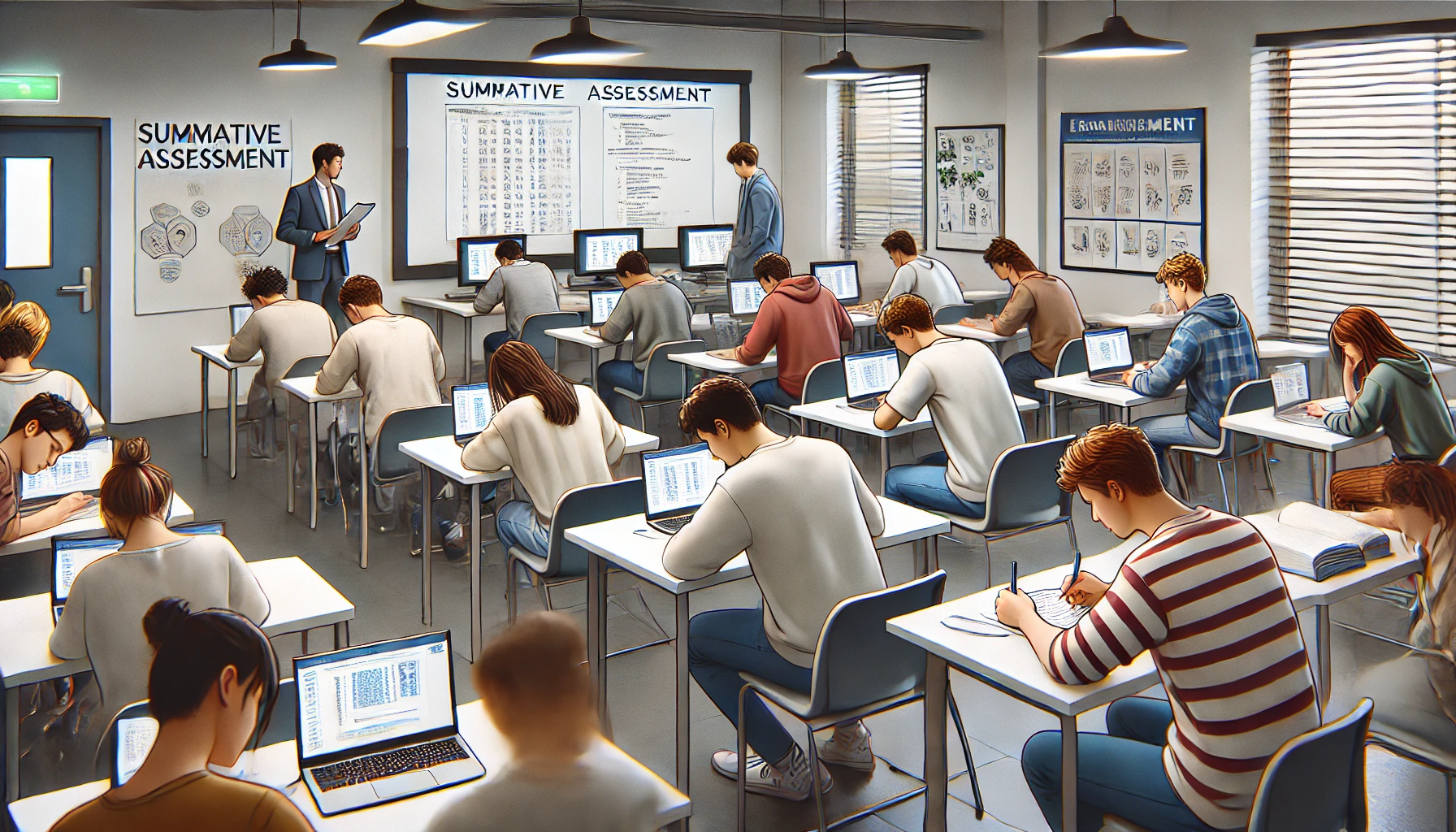
Summative Assessment
What is it?
Summative assessment in higher education refers to the evaluation of student learning at the conclusion of an instructional period, typically used to measure the extent to which students have achieved the learning objectives of a course or program. Unlike formative assessment, which is ongoing and intended to provide feedback for improvement, summative assessment is designed to evaluate cumulative student learning and performance.
Key characteristics of summative assessment include:
- Final Evaluation: It occurs at the end of a course, unit, or program to determine what students have learned and to what extent they have met the learning outcomes.
- Graded: Summative assessments are typically graded and contribute significantly to the final course grade.
- Comprehensive: These assessments cover a broad range of material and skills learned over the course period.
- High Stakes: They often carry significant weight in determining a student’s academic achievement and progression.
Why should Faculty use Summative Assessments?
Faculty should use summative assessment for several important reasons:
- Measuring Student Learning: Summative assessments provide a clear measure of how well students have understood and retained the course material. They help determine if students have met the learning objectives and outcomes set for the course.
- Certifying Competence: These assessments certify that students have achieved the necessary level of competence in a subject area. This is crucial for validating their readiness for subsequent courses, professional qualifications, or graduation.
- Accountability: Summative assessments ensure accountability for both students and educators. They help verify that the educational institution is delivering high-quality instruction and that students are achieving the expected standards.
- Providing Feedback: While summative assessments are primarily evaluative, they also offer valuable feedback to students on their overall performance. This feedback can guide students in understanding their strengths and areas for improvement, even after the course has ended.
- Guiding Instructional Improvements: The results of summative assessments can provide insights into the effectiveness of the curriculum and teaching methods. Faculty can analyze these results to identify patterns, strengths, and weaknesses in their instruction, leading to informed adjustments and improvements.
- Informing Curriculum Development: Data from summative assessments can inform decisions about curriculum design and development. It helps ensure that the curriculum remains relevant, comprehensive, and aligned with learning outcomes.
- Benchmarking and Standardization: Summative assessments provide a standardized way to measure and compare student performance across different sections of a course, programs, or institutions. This benchmarking is essential for maintaining consistency and quality in education.
- Supporting Academic Decisions: Summative assessment results play a key role in making academic decisions, such as promotions, placements, and awards. They help determine if students are ready to advance to the next level of their education or enter the workforce.
- Enhancing Student Motivation: Knowing that their performance will be formally evaluated can motivate students to engage more deeply with the course material and put forth their best effort.
- Ensuring Fairness and Transparency: Well-designed summative assessments provide a fair and transparent way to evaluate student performance. They ensure that all students are assessed based on the same criteria and standards.
How do Faculty Implement Summative Assessments?
Faculty use summative assessments in various ways to evaluate student learning and ensure that educational goals are met. Here are some common methods and practices:
- Final Exams:
- Written Exams: Traditional exams that may include multiple-choice questions, short answers, essays, and problem-solving questions.
- Online Exams: Digital versions of final exams, often with features like timed sections and automatic grading for certain question types.
- Major Projects and Portfolios:
- Individual Projects: Assignments that require students to apply their knowledge and skills to a specific task or problem, often culminating in a written report or presentation.
- Portfolios: Collections of students’ work over the course of the semester, showcasing their learning progress and achievements.
- Term Papers and Research Projects:
- Research Papers: In-depth studies on specific topics requiring extensive literature review, data collection, analysis, and synthesis.
- Term Papers: Essays or reports on course-related topics that demonstrate students’ understanding and analytical abilities.
- Capstone Projects:
- Capstone Courses: Final-year projects that integrate knowledge from the entire program, often involving real-world applications and collaboration with external partners.
- Theses and Dissertations: Comprehensive research projects typically required for graduate degrees, involving original research and extensive writing.
- Oral Examinations:
- Viva Voce: Oral defense of a thesis or dissertation where students present their work and answer questions from a panel of examiners.
- Presentations: Students present their research findings, projects, or papers to the class or a group of faculty members.
- Standardized Tests:
- Subject-Specific Tests: Exams focused on specific disciplines or subject areas, often used for professional certification or accreditation.
- Comprehensive Exams: Cumulative exams covering all major topics in a program, used to assess students’ readiness for graduation or advanced study.
- Case Studies and Practical Exams:
- Case Analysis: Assignments that require students to apply theoretical knowledge to real-world scenarios, often followed by written reports or presentations.
- Practical Exams: Hands-on assessments in fields like nursing, engineering, or the arts, where students demonstrate their practical skills and competencies.
- Peer and Self-Assessment:
- Peer Reviews: Students evaluate each other’s work using standardized rubrics, providing constructive feedback.
- Self-Assessments: Students reflect on their own learning and performance, often as part of a larger portfolio or project.
- Group Projects and Collaborative Assessments:
- Team Projects: Group assignments that require collaboration and collective problem-solving, resulting in a shared final product or presentation.
- Group Presentations: Teams of students present their findings or projects to the class, demonstrating teamwork and communication skills.
- Online and Blended Assessments:
- ePortfolios: Digital collections of student work, often including multimedia elements and reflective writing.
- Online Quizzes and Tests: Assessments conducted through learning management systems, with features like auto-grading and immediate feedback.